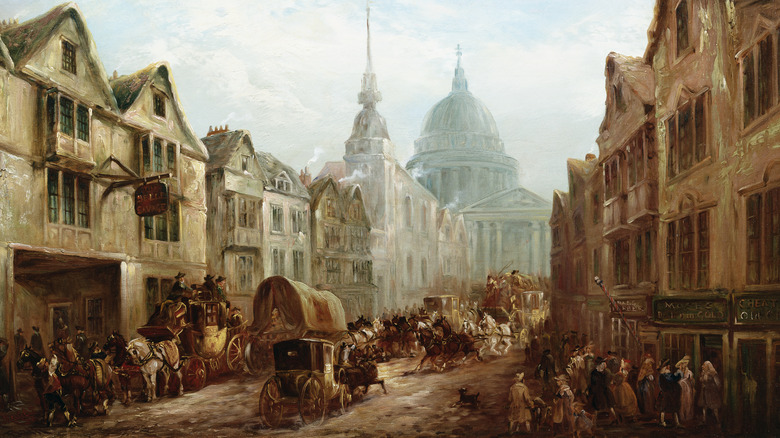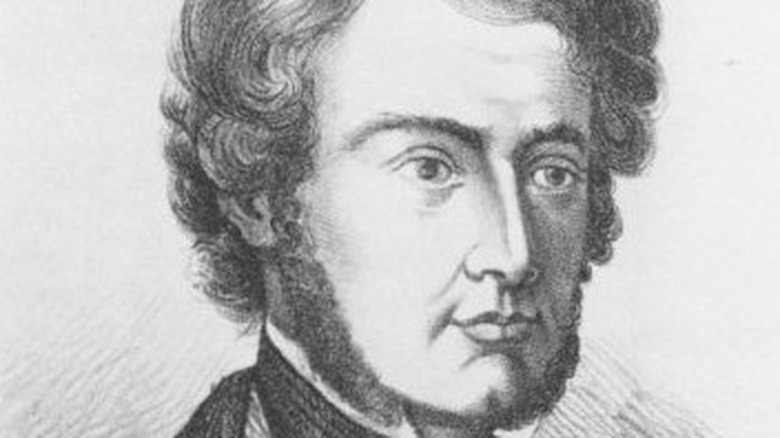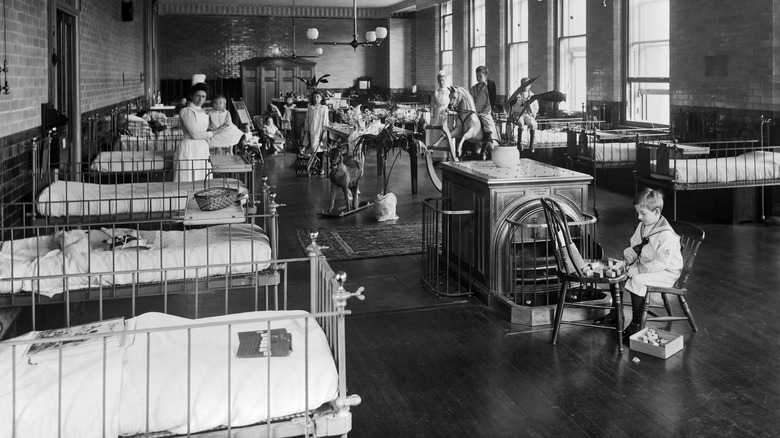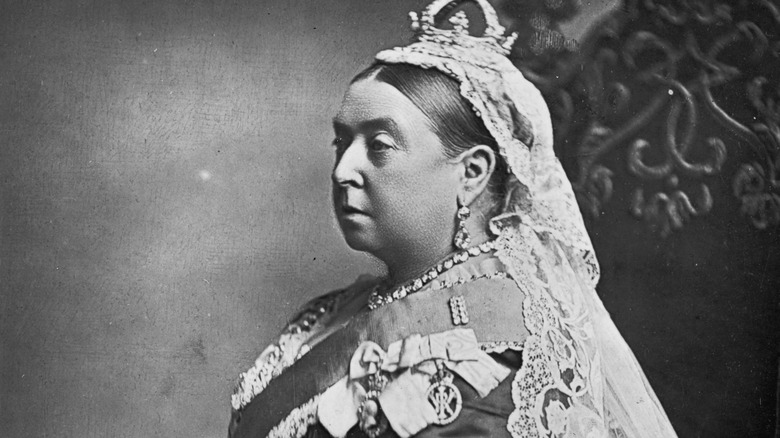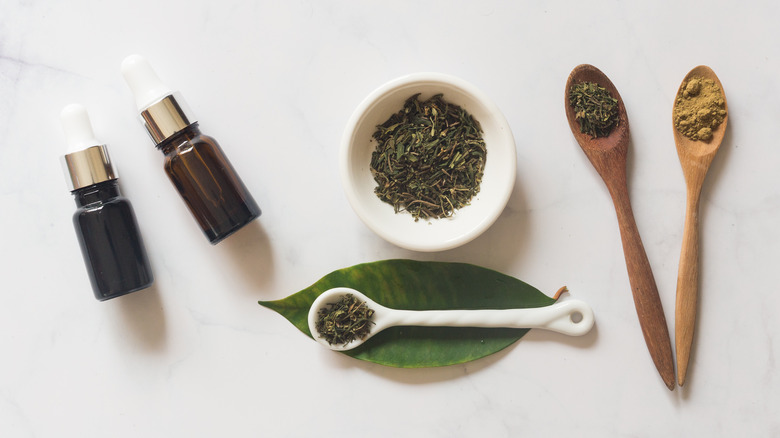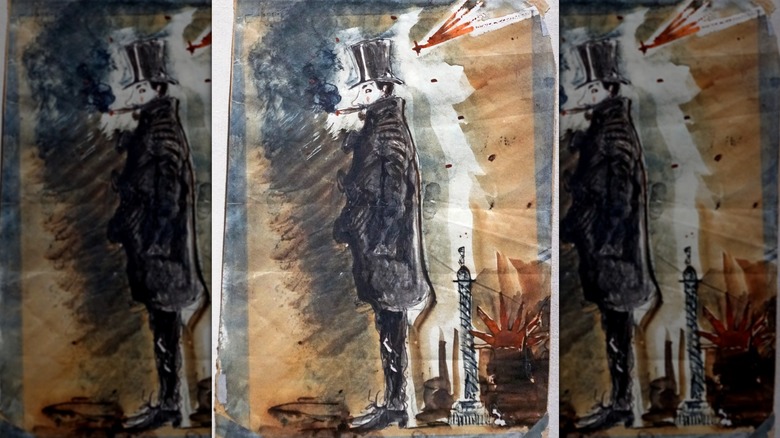How Marijuana Was Used In Victorian England
In popular culture, marijuana seems to be a drug of the 20th century and beyond. There was hysteria over cannabis smokers during the Jazz Age and the Great Depression, the swirl of sex, drugs, and rock 'n' roll in the 1960s and 70s, and an ongoing association between pot and campus life. It's not a drug we expect to see in earlier eras. Depictions of Victorian society, for instance, might show opium dens, and all but the most sanitized will feature plenty of tobacco — but no weed, pot, reefer, dope, or ganja.
But cannabis, under any name, didn't just appear in the early 1900s. According to the University of Sydney, humanity's made use of it since at least 2800 B.C., and there are indications that it was introduced from Asia into India, ancient Greece, and Roman society as medicine. Pliny the Elder described its use in treating joint pain, gout, upset stomach in animals, and ear infestations (he also described side effects of headache and impotence). However, its use in the West was curbed after Pope Innocent VIII condemned it in 1484 (per New Scientist).
According to a 1998 report by the Select Committee on Science and Technology in the House of Lords, there was a renewed interest in marijuana in the Western world in the 16th century, though verification of reported benefits was often lacking (via Parliament.uk). English travelers returned from Asia with claims of its effects, and Samuel Carey discussed its recreational use in 1833. But by the beginning of the Victorian era, the efforts of an Irish doctor were poised to inject marijuana into British medicine in a big way.
William Brooke O'Shaughnessy encountered medical marijuana in India
The man who reintroduced the Victorian world to marijuana was an Irish physician named William Brooke O'Shaughnessy. Per Ancestral Line, he was born in 1808 — most likely in Limerick — and studied medicine at Trinity College and the University of Edinburgh. He was unable to get a license to practice medicine in London after graduating, but he set up his own laboratory and became noted for his work analyzing the blood and feces of cholera victims. Per New Scientist, his work helped end the practice of using bloodletting to treat cholera patients who suffered from dehydration.
By 1838, O'Shaughnessy was an assistant surgeon in the Bengal Medical Service of the East India Company. Based in Calcutta, he became aware of marijuana's use as a recreational drug and medicine. As bang, dried marijuana leaves were smoked straight (a blend of flower buds and tobacco was smoked as gunjah). As majoon, the leaves were mixed with milk and sugar to make candy. And as churrus, the resin from the plant, O'Shaughnessy thought he had a viable medicine to experiment with.
[Featured image via Wikimedia Commons | Cropped and scaled]
Marijuana was used to treat mild to moderate ailments
After experimenting on a variety of animals, none of which suffered any harm even at the strongest doses administered, William Brooke O'Shaughnessy decided to use marijuana in its resin form to treat three male patients suffering from rheumatism (per New Scientist). At first, the drug only seemed to affect one man, who became excessively chatty and hungry before falling asleep. That same patient later became cataleptic, while another broke into hysterical laughter. But all three patients declared themselves relieved of any pain the next day, and O'Shaughnessy discharged them as cured.
He expanded his trials to include other diseases. Against his old fascination, cholera, O'Shaughnessy found that marijuana could relieve diarrhea and aid in patients' natural recovery. Against tetanus, it arrested spasms. When treating rabies, it couldn't do much more than ease patients' passing. Nevertheless, O'Shaughnessy was sufficiently convinced of marijuana's value that he wrote up his findings for the Provincial Medical Journal in 1842.
The paper electrified Victorian medical society. O'Shaughnessy was in London at the time his work appeared and was frequently contacted by his peers, who were eager to learn more about marijuana. Per Ancestral Line, he went on to work with the telegraph in India, for which he was knighted in 1856, and he laid the foundations for intravenous therapy. Meanwhile, his work with marijuana placed the drug in pharmacology books throughout Britain and Europe.
Did Queen Victoria use marijuana?
Per the 1998 committee report in the House of Lords, after marijuana was accepted as a viable medicine by Victorian Britain, it was primarily administered via tincture, an extract dissolved in alcohol and taken orally. Besides the conditions William Brooke O'Shaughnessy had used it for, marijuana was adopted as a treatment for insanity, as a general sedative, and as an aid in childbirth (per Gresham College). It was also considered useful in treating dysmenorrhea, or painful menstrual periods.
Among those who promoted marijuana's use for the latter condition was John Russell Reynolds, who published his thoughts on the issue in an 1890 issue of The Lancet. Per Advances in Clinical Neuroscience and Rehabilitation, he became a physician to the royal household in 1879. This has sometimes been misconstrued as Reynolds being the personal physician of Queen Victoria. The editors of "Women and Cannabis: Medicine, Science, and Sociology" made that mistake in the same paragraph where they claimed that the queen regularly took indica to deal with menstrual pain. But Victoria was 60 by the time Reynolds began working in the royal household, and as the Lords report noted, there is absolutely no proof that she used any strain of marijuana.
Quality control was an issue for Victorian marijuana
While Victorian society found marijuana a useful treatment for everything from migraines to epilepsy, it wasn't always a reliable medicine. Synthetic pharmacology began to take off in the late 19th century, but the active ingredient in marijuana — tetrahydrocannabinol (THC) — wasn't discovered until 1964. All medical preparations of the drug were entirely organic, and as Professor James Mills explained during a lecture at Gresham College, how much of the active ingredient one could get in a given batch of cannabis varied widely. As such, its efficacy and side effects couldn't be reliably predicted.
Marijuana was at another disadvantage compared to its contemporary treatments in Victorian society. Per National Museums Scotland, the hypodermic needle was developed in 1853, and it offered improved ways of administering treatments. But marijuana isn't water-soluble, which made it ill-suited for administration by injection. Between such technological innovations and the development of synthetic drugs, marijuana and other herbal remedies gradually fell out of favor — until they were all but displaced by the early 20th century.
Marijuana's reputation was tainted by opium and insanity
Practical considerations and the drug's own limits drove marijuana's decline as medicine at the end of the Victorian era. But the latter half of the 19th century was also when cannabis began to gain a sinister reputation in Britain and America. According to Professor James Milles' lecture at Gresham College, In 1891, the Allahabad Pioneer reported on the growth and sale of marijuana and its effects on mentally ill patients in British-controlled India. The paper argued that "ganja" was not only comparable to opium in its harmful effects, but worse. For evidence, the article pointed to alleged widespread use of marijuana among asylum patients.
The Pioneer's claims attracted attention in the House of Commons back in Britain, particularly among politicians active in the campaign against opium. Besides the harmful effects of opium, it was regarded as a symbol of the evils of imperialism for Liberal politicians opposed to the British Empire. The government's policy on marijuana was taxation over prohibition, but as anecdotal reports of marijuana's harmful effects became more widespread in the 1890s, the same Liberals who used opium as a weapon against imperialists latched onto cannabis as another bludgeon.
Cannabis became the compromise between the government and its opponents on the drug issue. Marijuana was less of a hot-button issue on both sides, but a commission carried out a study on its effects between 1893 and 1894. It found little to no evidence that marijuana was linked to insanity, but it did caution that excessive use could damage mental health — without defining "excessive."
